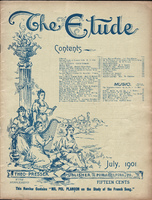It is difficult to understand why players who have already acquired a fair degree of digital skill persist in ignoring one of the safest, and at the same time one of the most transparent, principles of left-hand technic. I allude to the unfortunate habit of prematurely lifting the fingers (more especially the first and second) from what is obviously their natural position on the strings. In the ascending scale, for instance, it is not utterly unpractical—to use no stronger term— to lift each finger in succession immediately after it has performed its work of creating a tone? Does any experienced player really believe that this is the only work required of the fingers—that they have no other technical duties to perform? To create tone is, naturally, the first requirement of the fingers; but, in addition to this primary reason, continued finger-pressure is frequently a great advantage, often an undeniable necessity. Imagine the result of an attempt to raise each finger, immediately after a tone has been produced, in an ascending scale of great rapidity. The result would be both ludicrous and disastrous. Yet the very players who can easily recognize the absurdity of such a procedure constantly lift the fingers when great speed is not required.
Viewing the question from another stand-point, it is more than desirable to keep the first finger on the string wherever and whenever this is possible. Such a habit materially aids perfect intonation. Habitual pressure of the first finger upon the string solidifies the position of the whole hand, with the result that perfect intonation, if not actually assured, is at least greatly facilitated.
Regarding this question from still another standpoint, let us see what practical advantages accrue from such a habit.
The first illustration elucidates the disadvantage of prematurely lifting the second finger. A fine legato connection between f and d becomes unnecessarily difficult if the second finger abandons its position before the third finger has actually been employed. Furthermore, the premature lifting of the second finger in such a case generally causes the open D-string to be heard.
The second illustration offers yet more convincing evidence of the folly of lifting fingers prematurely. The second and fourth fingers being, as indicated, twice employed, it is, first, a waste of strength and energy to compel them to do twice what they need do only once; and, secondly, a slight disturbance of tone ensues from such an illogical technical method.
Almost every musical phrase offers some opportunity of testing the advantage of keeping the first and second fingers employed in pressing the string when no other work is required of them. Much could be said on this subject, and many instances given, further to elucidate the principles of technic here involved; but these few words of warning answer my present purpose.




